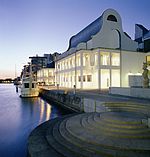Simhallsbadet, Helsingborg
Buildings and structures in HelsingborgSports venues in the Øresund RegionSwimming venues in Sweden

Simhallsbadet is a swimming venue in Helsingborg. It hosts a 25 m swimming pool, another smaller pool and a sauna. The building was designed by the Swedish architect Mogens Mogensen and completed in 1941. Mogensen had presented the plans in 1936; it was built between 1939 and 1941. Simhallsbadet was built as part of a project to address sanitation problems in south Helsingborg. The building is built in brown Helsingborg brick. The entrance part is built in a functionalistic style, while the pool section has a vaulted copper roof and a glass facade facing the street Carl Krooks gata. The building was renovated in 2001.
Excerpt from the Wikipedia article Simhallsbadet, Helsingborg (License: CC BY-SA 3.0, Authors, Images).Simhallsbadet, Helsingborg
Södergatan, Helsingborg Söder
Geographical coordinates (GPS) Address Nearby Places Show on map
Geographical coordinates (GPS)
| Latitude | Longitude |
|---|---|
| N 56.039062 ° | E 12.703114 ° |
Address
Södergatan 41
252 25 Helsingborg, Söder
Sweden
Open on Google Maps











